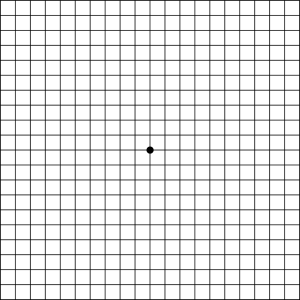Age-related macular degeneration, or AMD, is a gradual deterioration of the macula – a small part of the retina’s light sensitive tissue – which is responsible for clear, detailed vision.
Age-related macular degeneration affects your central field of vision and makes it hard to see details clearly.
Age-related macular degeneration affects your central field of vision and makes it hard to see details clearly. Age-related macular degeneration is painless but central vision will gradually appear distorted, blurry, or blind spotsmay develop.
It is important to note that there are two variations of prognosis for age-related macular degenerations, “wet” and “dry”. This page covers the dry prognosis and treatment of age-related macular degeneration. Click here to read about the wet age-related macular degeneration.
Please note, this page covers the “dry” form of age-related macular degeneration (dry AMD)
The dry form of age-related macular degeneration is the most common form and is characterized by the appearance of yellow or white deposits in the macula, known as drusen. As these drusen appear in number and grow in size they lead to increased distortion in vision.
In later stages of dry macular degeneration, a thinning of the macula may gradually lead to the formation of blind spots and a loss of central vision in advanced cases.
Symptoms of Dry Age-Related Macular Degeneration
The dry form of age-related macular degeneration has few symptoms in the early stages, which is why regular eye exams are important. As the macula gradually deteriorates, first sign is often increased difficulty seeing fine details.
In the dry form, vision loss happens gradually.
Common symptoms associated with the dry form of age-related macular degeneration include:
- Increased difficulty seeing fine details. For example, reading small print, writing, watching television, and doing everyday activities
- The centre field of vision may appear distorted or blurry
- Dark spots or white outs appearing in the centre of your visual field
- Reduced ability to perceive and distinguish between colours
- In advanced stages, a loss of central vision
For most patients, the symptoms of age-related macular degeneration usually occur in both eyes but it is possible for changes to affect only one eye.
Causes of Dry Age-Related Macular Degeneration
Age-related macular degeneration is one of the leading causes of vision loss among adults.
The main factors that put you at greater risk of developing age-related macular degeneration include:
- Over the age of 60 years old
- Family history of age-related macular degeneration
- History of smoking
- History of high blood pressure
- High cholesterol or obesity
- More common among women than men
Diagnosing Dry Age-Related Macular Degeneration
Age-related macular degeneration can be detected during a dilated eye exam by your eye care professional.
A basic test that may also be used is for the patient to look at an Amsler grid. An example of an Amsler grid is included below.

This grid is outlined like a chess / checker board with vertical and horizontal lines. If any of the lines appear wavy, missing, or if blind spots appear, this may be a sign that you have macular degeneration.
If the presence of age-related macular degeneration is detected, your ophthalmologist or retinal specialist will likely recommend a fluorescein angiogram test. This test is to view the blood vessels within your eye and identify any leaking blood vessels that could be causing further damage to your eyesight. This test is more common for the wet form of age-related macular degeneration, but may be recommended for dry cases as a precaution.
Treatment of Dry Age-Related Macular Degeneration
Treating the dry form of age-related macular degeneration will slow the progression of vision loss, but there is currently no cure.
Treating the dry form of age-related macular degeneration will slow the progression of vision loss – and in some cases, help to regain vision that was previously lost – but there is currently no cure. While dry age-related macular degeneration is relatively less severe than the wet form, it is important to seek treatment at the earliest possible stage in order to maintain healthy eyesight.
The most common treatment for the dry form of age-related macular degeneration in the intermediate or advanced stage is a regular, high dosage of antioxidant vitamins and zinc. The exact formulation of vitamin intake will be provided by your retina specialist. Additional intake of lutein and omega 3 fatty acids such as fish oil and flax seed have also been shown to help reduce the vision loss caused by dry age-related macular degeneration.
For all patients diagnosed with age-related macular degeneration, even for those undergoing treatment, you are recommended to check your vision daily and to notify your retinal specialist if there are any noticeable changes in your vision.